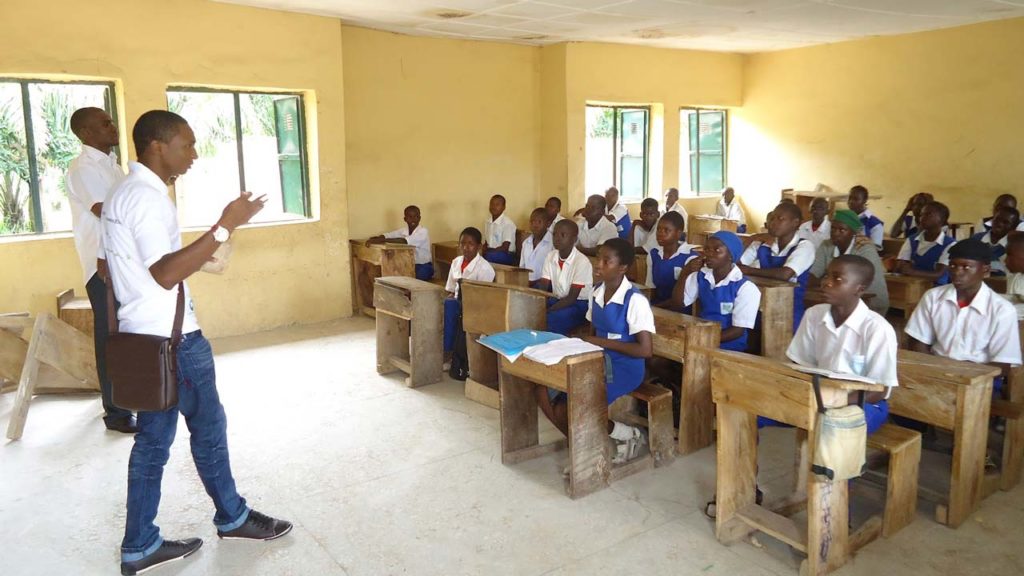In Nigeria, education seems to be a never ending challenge thwarted by economics, politics, cultural beliefs, and more. Though there are areas with marked improvement, education in the country as a whole remains to be an issue. According to Unicef, 10.5 million of the 263 million children and adolescents denied their right to education are In Nigeria. Those 10.5 million children are aged 5 to 14 years old and, overall, only 61% regularly attend primary school – a level of education that is provided for free and is, technically, compulsory.
More than 5% of these children are In the northeast of the country. In states impacted heavily by conflict where more than 800 schools remain closed and close to 500 classrooms have been destroyed.
Nigeria’s Commitments
Nigeria is, of course, one of the UN member states committed to the Sustainable Development Goals (SDGs), which were adopted by all United Nations Member States in 2015. The SDGs are a universal call to action to end poverty, protect the planet, and ensure that all people enjoy peace and prosperity by 2030. Nigeria is also committed to the African Union Agenda 2063 to build a more prosperous Africa. On the back of these commitments, Africa has seen progress in enrolling more children in primary education. There is still much to be done, especially for the school-aged children of Nigeria and the future generations of the country.
Innovative Technology in Education
For some, innovation is synonymous with technology. There are numerous examples from around the world where technology has succeeded in increasing the number of children receiving education and also the quality of education.
Robot Teachers
In South Korean for example, telepresence robots have been used to provide English lessons to elementary-aged pupils. Telepresence robot technology is one that is becoming increasingly affordable and could potentially offer a solution to areas that lack qualified teachers. Instead of in a human teacher lessons are taught via a screen on the robot on which the face of a teacher who could be based anywhere in the world is shown. This high tech teacher robot is a potential solution for connecting global educators with Nigeria’s school children.
3D and Virtual Reality Tools
At a school in Dubai, science lessons are being delivered using a 3D platform which enables the students to become emersed in the lessons at hand. Whilst at the British School of Brussels, Tervuren, Belgium, the school is experimenting with the use of virtual reality as a learning tool. In these trials, 10 – 11-year-olds have worn virtual reality goggles as part of history and geography modules. According to primary school teacher Stephen Coyne, the use of the goggles resulted in students being more engaged with the topic.
Similarly, technology innovators like Google and Jio have developed mixed reality glasses that allow students to access apps and content that might otherwise be unavailable.
These advanced technology options allow schools to bridge the educational gaps between what is available in their country and what can be accessed with a little help from technology.
Educational Innovation in The Community
For regions that are struggling economically or are faced with the barriers created by corruption, expensive technologies are not always an option. It would be unfair to tote it as a one-fits-all solution. Innovation takes many forms, some more accessible for poorer states than others.
Nigerian NGO The Development Research and Projects Center (dRPC) ran a project aimed at increasing learning and creating income opportunities for girls in the Kano and Jigawa states. The project was a success with an 80% increase in the number of graduating students. What the study found was that of the high number who graduated only a third of them went on to continue with their education and two-thirds went on to get married or stay at home.
In a spin of off the project, dPRC assisted 40 girls, who had not done as well in their lesson, to start their own business within their communities. Fast forward three years and 39 of those girls are still running their businesses – which in turn educates more children as they are all running affordable early childhood development (ECD) centers. Half of these students plan to retake the school exams and 10 are planning to enroll in further teacher training.
What can be learned from the work of the dRPC is that education requires adaptability and that in reality, where ever they are in the world not all students will excel with education. However, with support and innovation that continues around their lessons and after their education, students of all abilities can excel. As Judith-Ann Walker, managing director of the dRPC says “innovation is not a thing but an ever-evolving dynamic process of adaptation.”
AUTHOR: Ashley Halsey is an education writer at Essay writing services UK who travels extensively to talk about innovation in education. She is a mother of three who enjoys long-distance cycling in her spare time.
